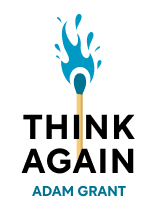

This article is an excerpt from the Shortform book guide to "Think Again" by Adam Grant. Shortform has the world's best summaries and analyses of books you should be reading.
Like this article? Sign up for a free trial here.
Are you looking for Adam Grant’s Think Again quotes? What are some of the most noteworthy passages worth revisiting?
In Think Again, Adam Grant shows how knowledge and expertise often confine us to narrow ways of thinking that limit our potential. He argues that instead of pursuing expertise, we should practice and pursue reconsideration because it opens new doors of learning and self-awareness—and, as a teachable skill, reconsideration is something you can develop, share with others, and apply to your life and work.
Below is a selection of Think Again quotes by Adam Grant.
Think Again: The Power of Knowing What You Don’t Know
You likely believe that precise knowledge is valuable and that maintaining strong beliefs shows integrity. But according to social scientist and Wharton professor Adam Grant, reconsideration, or the ability to reconsider your views, is much more valuable than knowledge or loyalty to your beliefs.
The following Adam Grant’s Think Again quotes highlight some of the key ideas.
“Lectures aren’t designed to accommodate dialogue or disagreement; they turn students into passive receivers of information rather than active thinkers.”
Grant critiques traditional education methods such as lecture and memorization as inadequately challenging students to think independently. These methods teach students to repeat the information they learn but not how to engage meaningfully with the material. As a result, they don’t develop adequate critical thinking skills. Instead of lecture and memorization, Grant advocates for an active-learning method that encourages students to question their thinking and engage curiously and meaningfully with other people’s ideas.
Grant provides some suggestions for encouraging active learning and reconsideration:
One method is to assign projects that involve multiple drafts with peer feedback (feedback that a small peer group provides)—having students complete multiple drafts shows them that they may need to make mistakes and reconsider their ideas several times in order to meet the project goals.
Teachers can also encourage students to share their passions—when students hear about the interests of their peers, they realize that other students have something to teach them and that they might benefit from the ideas of others.
Finally, teachers can empower students to question widely accepted beliefs—Grant says that teachers should create lessons that debunk myths and challenge conventional thinking.
“Psychological safety is not a matter of relaxing standards, making people comfortable, being nice and agreeable, or giving unconditional praise. It’s fostering a climate of respect, trust, and openness in which people can raise concerns and suggestions without fear of reprisal. It’s the foundation of a learning culture.”
Great ideas go unexpressed when workplaces don’t try to cultivate a sense of psychological safety—people fear the negative consequences of being wrong, so they hesitate to speak up. In such a culture, old ways of doing things go unquestioned because people are stigmatized for challenging them. When this dynamic sets in, the workplace can become wedded to old ideas and processes that clearly aren’t working anymore, while new ideas are stifled and ignored—leading the entire organization to suffer as a result.
To avoid this outcome, leaders should focus on creating psychological safety in the workplace by communicating that it’s ok to be wrong. Even better, they can openly share professional critiques that show their past failures. When leaders are open about their own shortcomings and how they are working to do better, it provides a powerful example of humility that gives employees the psychological safety to struggle and make mistakes too.
“Stereotypes don’t have the structural integrity of a carefully built ship. They’re more like a tower in the game of Jenga – teetering on a small number of blocks, with some key supports missing. To knock it over, sometimes all we need to do is give it a poke. The hope is that people will rise to the occasion and build new beliefs on a stronger foundation.”
Stereotypes often stem from a lack of awareness about the complexity of the perspectives of others. Grant suggests thinking hypothetically about what you would be like if you had a different background—you’ll likely come to realize that the experiences of others are much more complex than you’d assumed. He suggests some “hypotheses” to examine, such as: Could I be wrong about how I think about this group of people? Is it really true that all X people do Y? How does their background differ from mine, and how has that informed the different ways we live?
This sparks the Reconsideration Process—you realize that your stereotypes are incorrect, seek correct information about different groups, and come away with a nuanced understanding of them rather than a stereotype.

———End of Preview———
Like what you just read? Read the rest of the world's best book summary and analysis of Adam Grant's "Think Again" at Shortform.
Here's what you'll find in our full Think Again summary:
- Why the ability to reconsider is more important than precise knowledge
- How knowledge and expertise can narrow your thinking and limit your potential
- How to improve your ability to reconsider things in work and in life






